What or who is ELVAS? A few years ago I wrote about the future of hearing aids, specifically the convergence of devices (hearing aids, cell phones, computers) and how they would be able to talk to one another, wirelessly. I called this converged device an Ear Level Voice Activated System or ELVAS, as it would function by responding to voice commands (Dybala, 1999).
At the time the article was written, I wondered how long it would be until I experienced my first "ELVAS sighting" or even a "near-ELVAS sighting". Fast forward to today, where a technology convergence trend is centered around the mobile phone. I looked through a recent issue of a technology related magazine (Wired, November, 2005) to find examples of the type of technologies that have been combined with the mobile phone. This list of features included:
- Network computers
- Web browsers
- Email clients
- Digital still cameras
- Global Positioning Systems
- Satellite Radios
- Personal Digital Assistants - Calendar Functions - Contact / Address
List - Voice Dialing
- Voice Recorders
- Gaming Consoles
- Text Messaging
- Streaming Audio and Video Players
- Clocks / Alarms
- Digital video recorders
- Digital file storage
- FM Radios
- Bluetooth wireless connections
- Two-way radios (walkie-talkie function)
Wired Magazine, Volume 13, Number 9
One of the items that brought the idea of ELVAS type devices back to the forefront of my mind was the November, 2005 issue of Wired magazine. Wired (www.Wired.com) is a ground breaking, award winning magazine on modern technology and business. It's one of my favorite periodicals out of several business and technology magazine subscriptions that I read. The November issue contained not just one, but three different items that I thought were related to the hearing healthcare field, and the ELVAS type concept.* Out of the three items, the one that really got my attention was an image from a two-page advertising spread on pages 128 and 129. It was for a Plantronics Wireless Bluetooth** headset. A "high-tech" headset was worn by an attractive young woman on one page, and then independently featured on the second page, the headset is shown in Figure 1.
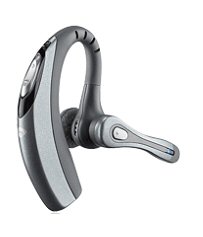
Figure 1. Plantronics Voyager 510 Bluetooth Headset (www.plantronics.com).
When I first saw the headset above, I thought I was experiencing my first ELVAS sighting! One could just imagine millions of people using devices like this with their mobile phones (or this device is their mobile phone) and unless you look closely, you can't tell if this device is a traditional hearing aid or not! Imagine the boom containing a second-order array directional microphone. Imagine these devices enabling instant listening networks for small or larger groups in noisy situations. Imagine these items patching into any and all public theatre and home entertainment systems. The possibilities explode and the stigma of wearing a "hearing aid" becomes non-existent.*
ELVAS Lives!
I then wondered if this hearing aid / headset look a-like phenomenon is happening with other devices besides the Plantronics Voyager 510 headset. Various search engine tools were used to identify if there were other headsets that looked like hearing aids, or possibly, hearing aids that looked like headsets. Two "rules" were used for the purpose of this exercise: (1) A hearing aid was defined as a device that was programmed so that the amplification could be customized based on the user's hearing loss. (2) A headset was defined as a device that could have an overall volume control, but it could not have controls to program the device based on a specific hearing loss profile.
Read on to see the results, and "play along" to see if you can tell the difference. If you would like to "hide" the answers as you scroll down the page, just remember they are given right after the caption for each figure. I think you will agree that the lines between some of these devices are starting to blur!
Mobile Phone Headset or Hearing Aid?
Take a look at Figure 2 and decide, headset or hearing aid?

Figure 2. Mystery Device A.
The answer is ..... hearing aid. This is a device that will soon be widely released by Sound ID, called the Personal Sound System or PSS (www.soundid.com). It will work with Bluetooth enabled mobile phones, includes "Adaptive Noise Compensation" and "Personalized Digital Sound" algorithms, plus a directional microphone. "Sound ID is working to develop a new category of DSP-based personal sound enhancement products emphasizing communication and connectivity to revolutionize the way people experience sound and hearing." (Sound ID, 2005a). The web site suggests that it will be dispensed by audiologists, and it is for users with a mild to moderate hearing loss who want hearing assistance in specific situations (Sound ID, 2005b).
Ok, let's move onto the next one, take a look at Figure 3, headset or hearing aid?
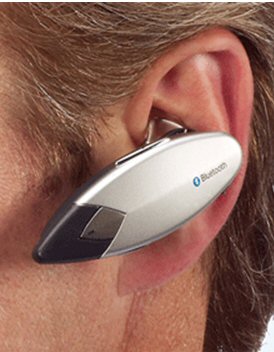
Figure 3. Mystery Device B.
The answer is ..... headset! This is the SoundPort manufactured by Starkey Labs (www.hearwireless.com). This headset attaches to the ear via a custom earmold, so the user would need to go to a hearing healthcare practitioner to get setup with this device via an earmold impression. The advantage is that with the custom earmold, this is a headset that you can easily wear all day long (Yanz & Dybala, 2005).
Ok, let's move onto the next one, take a look at Figure 4, headset or hearing aid?
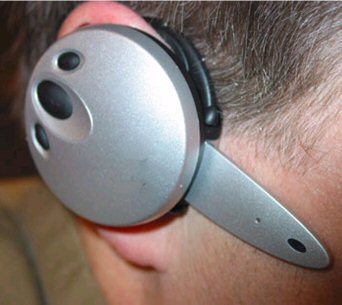
Figure 4. Mystery device C.
The answer is ..... headset! This is the Jabra BT 100 (www.jabra.com) and is a wireless Bluetooth headset for use with mobile phones.
Moving on, Figure 5, headset or hearing aid?
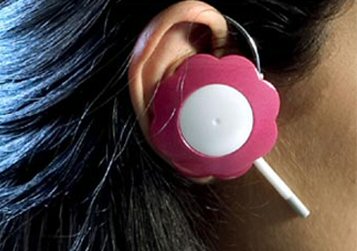
Figure 5. Mystery device D.
The answer is ..... hearing aid! This is not a hearing aid you can currently buy, but a hearing aid design concept called the "universal hear-ring". A basic core technology would be used with different outer rings that could be changed out for different colors or styles (Designboom, 2006). The hear-ring is a part of an exhibit coordinated between the Royal National Institute for the Deaf and Hard of Hearing (www.rnid.org.uk) and the magazine Blueprint (www.wdis.co.uk/blueprint/) with brand consultancy Wolff Olins (www.wolff-olins.com) in association with the Victoria & Albert Museum in London, England (www.vam.ac.uk). Some of the most prominent design studios in the UK were brought in to "radically re-think" the future of hearing and hearing aid design. More information about this exhibit can be found via the following web sites:
- https://www.vam.ac.uk/vastatic/microsites/1498_hearwear/player.php
- https://www.designboom.com/contemporary/hearwear.html
- https://www.rnid.org.uk/information_resources/hearing_aids/hearwear/
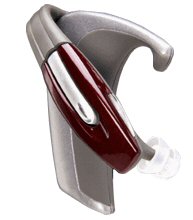
Figure 6. Mystery device E.
The answer is ..... hearing aid! The Gennum HearPhone (www.gennum.com/hp/) is a device that is very similar to the Sound ID PSS. It is Bluetooth compatible, but can also be used as a device to "...customize the quality of the sound you receive in face-to-face conversations" (Gennum, 2005a). One model has a 17 band graphic equalizer and the other has an 8 band. It includes wide-dynamic range compression, noise reduction, directional microphones, and active feedback cancellation. Gennum recommends in the user manual that these options be adjusted by your hearing healthcare provider (Gennum, 2005b). It is not surprising that the "hearing aid" technology mentioned above was included in the HearPhone as Gennum also sells this technology to some hearing aid manufacturers for use in many hearing aids sold today. Gennum has a version of this device for persons with normal hearing, the nXZEN and ZEN Bluetooth headsets.
Here is an easy one, take a look at Figure 7, headset or hearing aid?
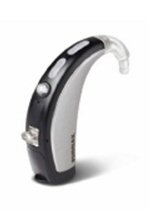
Figure 7. Mystery device F.
The answer is ..... hearing aid! Just wanted to make sure you were paying attention! This is the Phonak Savia 111 dSZ (www.phonak-us.com), please note the similarity to the Plantronics headset from the Wired advertisement shown in Figure 1.
Now take a look at Figure 8, headset or hearing aid?

Figure 8. Mystery device G.
The answer is ..... headset! The BT 500 (www.jabra.com) is another Bluetooth headset from Jabra. Now, I did alter this picture so the earpiece is missing, but I wanted you to focus on the part of the device that sits behind the ear.
Next device, headset or hearing aid?
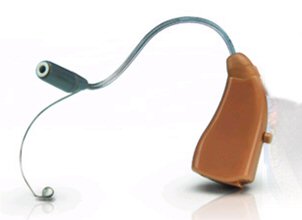
Figure 9. Mystery device H.
The answer is ..... hearing aid! The VivaTone Mini M44 (www.vivatone.com) is a part of a growing movement to offer open fit hearing aids for users with high-frequency hearing loss.
Ok just a few more! Next is Figure 10, headset or hearing aid?
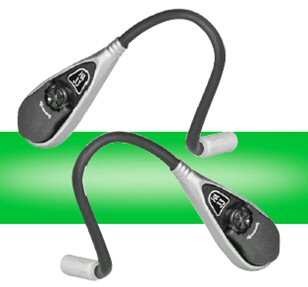
Figure 10. Mystery device I.
The answer is ..... headset! The Phonak EduLink (www.phonak-us.com) is an open fit FM receiver that was made for children with normal hearing. This device was developed for children who may have auditory processing or attention deficits and would benefit from an improved signal-to-noise ratio. The discreet EduLink gives a child with normal hearing the signal-to-noise ratio advantages of an FM system, without the child having to wear bulky headphones. This is another device that is made by a hearing aid manufacturer, but focuses on a segment with normal hearing.
Figure 11, headset or hearing aid?
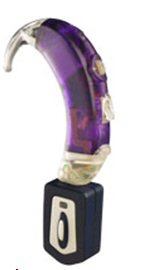
Figure 11. Mystery device J.
The answer is ..... hearing aid! ELI (Ear Level Instrument) is a Bluetooth device (www.elihearing.com) that is connected via DAI to the bottom of the hearing aid in the picture. ELI has been developed by Starkey to enable hearing aids to be compatible with Bluetooth enabled mobile phones. ELI is the world's smallest audio Bluetooth device and has recently been named by Time Magazine in the November 21, 2005 issue as one of the Best Inventions in 2005 (www.time.com/time/business/article/0,8599,1129522-3,00.html).
Next item, Figure 12, headset or hearing aid?
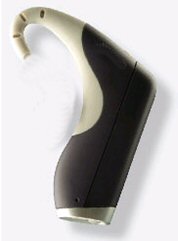
Figure 12. Mystery Device K.
The answer is ..... headset! The Jabra BT110 (www.jabra.com) is another Bluetooth headset for use with mobile phones. Just like in Figure 8, I removed the earpiece from the picture. A pattern that you might notice is that these Jabra headsets favor the behind-the-ear hearing aid design. This is no surprise when you realize that Jabra shares the parent company Great Nordic Corp. with the hearing aid manufacturer GN Resound (www.gnresound.com).
Ok, next item, lucky Figure 13!
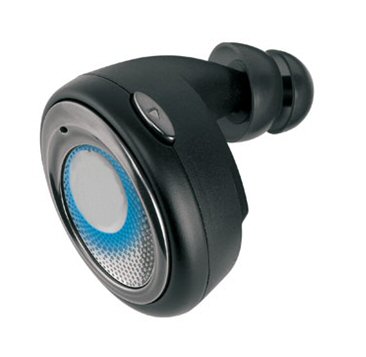
Figure 13. Mystery device L.
The answer is ..... headset! Modular in-the-ear hearing aid? Nope, a modular in-the-ear headset. Motorola (www.motorola.com) has just introduced the H5 MINIBLUE. "Designed around the way your body works, the in-ear microphone and speaker of the Motorola H5 MINIBLUE picks up your voice through the ear canal so conversations come in loud and clear - even in a noisy environment." (Motorola, 2006a)
Ok, here we go, last item. Figure 14, headset or hearing aid?

Figure 14. Mystery Device M.
The answer is ..... headset! This is the Oakley and Motorola converged RAZRWIRE (oakley.com/about/razrwire/). There is a different version of this device that functions not as a Bluetooth headset for your phone, but as a self contained MP3 player with stereo headphones (known as the Oakley Thump and Thump2). Oakley is a world leader in eyewear technology and endorsed by high-profile athletes such as Lance Armstrong (Cycling) and Tony Stewart (NASCAR). The irony in this device is that we moved away from eyeglass hearing aids many years ago, and now Oakley is making it fashionable to use what they call "Wearable Electronics". Coming later in 2006 will be a stereo headset for your Bluetooth enabled phone and MP3 players the O ROKR, see Figure 15. The headset is stated as having "High Definition Optics ®" and "...gives you absolute wireless freedom, digital stereo fidelity and patented optical clarity." (Motorola, 2006b)
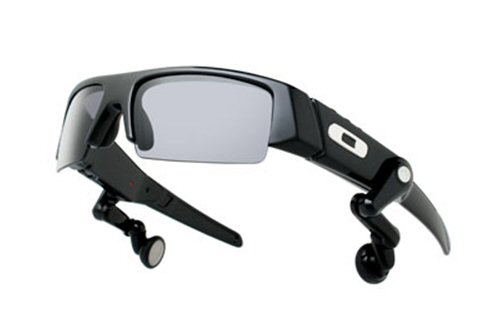
Figure 15. The O ROKR.
How did you do? What do you think?
Well, how many did you get "correct"? More importantly, did the pictures get you thinking about the future of hearing aids and ELVAS type devices? What strikes me the most is how some of the hearing aids look like headsets and some of the headsets are in fact hearing aids. I hope that this demonstration brought to light some of the future potential of these types of converged devices.
Will ELVAS cause hearing aids to go mainstream?
An interesting way to think about the potential of these converged devices was suggested to me by Jerry Yanz, Ph.D. of Starkey Laboratories (Personal communication, January, 19, 2006), and this was to think of them in reference to sunglasses. A person does not need sunglasses to "see", as sunglasses primarily function to enhance a person's ability to see in a given situation. This is especially evident in the way that Oakley markets its products as having "High Definition Optics®". The ELVASs of the future will be hearing enhancement products for persons with normal hearing and hearing impairment alike. Just like we have "prescription sunglasses" we will also have "prescription headsets" as well, and this would have an impact on the way that the general public thinks about hearing aids and the people who wear them.
If you would like a demonstration of what I am talking about, just imagine that the RAZRWIRE headset above in Figure 14 had a "hearing aid" capability built into it. Take a look at the TV advertisement for this headset that Motorola has created in Video 1 below.

Video 1. Motorola RAZR Wire TV advertisement. Note: You must have the free Windows Media Player (https://www.microsoft.com/windows/windowsmedia/) installed to see the video. Click here or on the image above to view video.
This is a quantum shift in how hearing aids could be marketed to the general public. Imagine a commercial such as this portraying "hearing enhancement devices" a.k.a. "hearing aids" as not only high-tech, but cool, sleek, elegant and even sexy. This would do wonders for the perception of hearing aids and the reduction of stigma and have a major positive impact on the hearing healthcare field.
ELVAS wearing an iPod?
One final trend that I would like to mention is that the mobile phone/headset may not be the only device that helps with the acceptance of hearing aids. The iPod sold over 32 million units in 2005, roughly one iPod sold every second for that year. The portable media player is quickly becoming as ubiquitous as the mobile phone. Portal Player Inc., manufacturer of the chip that is currently the "audio brains" inside the iPod, just announced an agreement with CSR, a leader in Bluetooth technology. The two companies will be working together to produce the next-generation system-on-chip that will include WiFi and Bluetooth capability (PortalPlayer, 2006, February 7). This would enable wireless iPods to become a reality as soon as the second half of 2006. Many of the wireless headsets shown above, including binaural wireless headsets, could then work just as easily with a Bluetooth enabled media player. This could further accelerate the "normality" or "acceptability" with which people are seen wearing "ear level devices".
Send in your ELVAS Sightings!
I would like to encourage the reader to please send along any comments about this article, especially if you have had any ELVAS type sightings. Send them to the Editor via the contact page here at Audiology Online. You may also send email to the user ELVAS here at Audiology Online. Be sure to add the @audiologyonline.com after the user name ELVAS. The two parts of the email address were separated to cut down on spam related submissions. I look forward to hearing from you and "Thank you, thank you very much" for your attention.
Acknowledgements
Special thanks to Gus Mueller, Ph.D. for feedback on this article and David Kirkwood, Editor of The Hearing Journal, for working with Audiology Online to enable this "topic simulcast" to occur.
Footnotes - back to article
*If the reader would like further information on this topic, please read the companion article published in the March, 2006 edition of The Hearing Journal, titled "ELVAS Sightings: Cochlear Implants and Hearing Aids get Wired" (Dybala, 2006). It includes a more thorough discussion on the three items from Wired, including implications of how the convergence trend could influence hearing aid stigma, the cost of hearing aids and the hearing healthcare industry in general.
**Discussion on the redundancy of the phrase "Wireless Bluetooth" or other similarly redundant phrases such as: "Pre-drilled holes", "KEMAR manikin", "GPS systems", "HINT test", "CFY year" and "Hot-water heaters" can be found in Dybala (2006).
About Paul Dybala
Dr. Dybala is the President and Editor of Audiology Online, the world leader in online hearing health education and information.
Works Cited
Designboom (2006). Hearware - the future of hearing. Retrieved on February 26, 2006, from https://www.designboom.com/contemporary/hearwear.html
Dybala, P.D. (1999). ELVAS (Ear Level Voice Activated System) Lives. Audiology and the New Millennium - A Special Issue of Audiology Today October, 2, 34.
Dybala, P.D. (2006). Page 10 - ELVAS Sightings: Cochlear Implants and Hearing Aids get Wired. The Hearing Journal, 59(3), 10-15. Also avalable online at Audiology Online
Gennum (2005a). About HearPhone. Retrieved on November 8, 2005, from
https://www.gennum.com/about_hearphone.htm
Gennum (2005b). Digital wireless headset with HearPhone Technology. Retrieved on November 8, 2005, from https://www.gennum.com/H3650user_manual.pdf
Motorola (2006a). Motorola H5 MINIBLUE. Retrieved on February 26, 2006, from https://www.motorola.com/motoinfo/product/details/0,,133,00.html
Motorola (2006b). Motorola O ROKR Bluetooth Stereo Eyewear. Retrieved on February 26, 2006, from https://www.motorola.com/motoinfo/product/details/0,,137,00.html
PortalPlayer (2006, February 7). CSR and PortalPlayer bring wireless connectivity to personal media players. Retrieved on February 26, 2006, from https://www.portalplayer.com/news-and-events/CSR_PPI.htm
Sound ID (2005a). Sound ID about page. Retrieved on November 23, 2005, from https://www.soundid.com/
Sound ID (2005b). Sound ID target audience. Retrieved on November 23, 2005, from https://www.soundid.com/
Yanz, J. & Dybala, P.D. (2005). Interview with Jerry Yanz, Ph.D., Senior Trainer, Starkey Laboratories. Audiology Online, Interview 373. Retrieved November 21, 2005 from the Article Archives on https://www.audiologyonline.com


